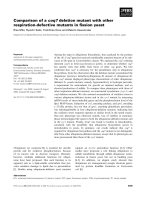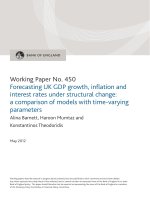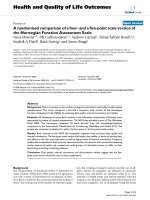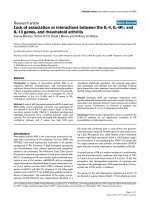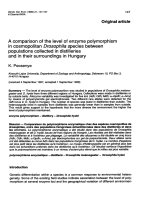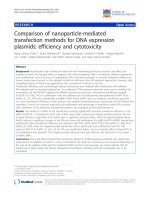Comparison of a structural behaviour between composite single-I encased steel beam and a double-I encased steel composite beam
Bạn đang xem bản rút gọn của tài liệu. Xem và tải ngay bản đầy đủ của tài liệu tại đây (193.52 KB, 3 trang )
Tuyển tập Hội nghị Khoa học thường niên năm 2017. ISBN: 978-604-82-2548-3
COMPARISON OF A STRUCTURAL BEHAVIOUR
BETWEEN COMPOSITE SINGLE-I ENCASED STEEL BEAM
AND A DOUBLE-I ENCASED STEEL COMPOSITE BEAM
Nghiem Tien Dung1 , Vu Thi Thu Thuy2
1
School of International Education, Thuyloi University, email:
2
Civil Engineering faculty, Thuyloi University
1. INTRODUCTION
Nowadays, the steel-concrete composite is
an advantageous solution that has been
widely used in many countries in the world
for multi-storied buildings. There have been
many studies on this subject throughout the
world. Books of Nethercot, 2003; Johnson,
2004; Pham, 2006; or the standards Eurocode
4 and AISC 2010, 2016 had published design
instructions for composite structures with
single encased steel profile. However, there
are no design standard guidelines for steelconcrete composite with multiple encased
steel
profiles.
Meanwhile,
several
international and domestic researchers have
published on steel-concrete composite
structures with multiple encased steel profiles
using physical and numerical models. Zhou
et al., 2010 presented experimental and
numerical studies of the composite shear wall
with multi-embedded steel sections. They
indicated that composite shear walls with
multi-embedded steel sections have better
energy dissipation capacity than that with a
single one. The presence of multi embedded
steel sections did not affect the final failure
mode of the composite shear walls, but they
would restrain the development of cracks and
prevent the concrete from severe spalling.
Tran, 2015 performed his experimental
results on the behavior of composite concrete
beams with 3 H-steel profiles. He also
provided some suggestions on model design
for this type of beam based on the results.
Tran and Vu, 2016 used Abaqus software to
model the steel-concrete composite beams
with 3 H-encased steel profiles and compare
the numerical results with Tran’s
experimental results. However, until now
there has been no study on the comparison of
behavior between composite beams with
single I-encased steel versus multiple Iencased steel.
This paper shows the results of modeling
two cases of the steel-concrete composite
beam: one with single-I steel and another
with double-I steel. Both cases have the same
steel area. Abaqus software was used to
simulate and compare the results between 2
cases in terms of bearing capacity,
displacement, stress/force and failure mode.
2. ABAQUS AND SET UP MODEL
Abaqus is one of the popular software for
structural analysis based on the finite element
method. Abaqus offers a wide range of
options for describing element types
separately, then assemble them to a 3D
completed object. Particularly, different
material models with many stages can be
described in detail using Abaqus. Also, the
appropriate results between the numerical
model and experiments of Tran and Vu, 2016
show that Abaqus is a useful tool to model 2
cases of this research.
Simply supported beam under bending is
selected for this research as Figure 1.
586
Tuyển tập Hội nghị Khoa học thường niên năm 2018. ISBN: 978-604-82-2548-3
are nonlinear. The parameters of I-encased
steel S355, longitudinal steel bars, and stirrup
are presented in Table 1. In which f y is yield
strength, fu is ultimate strength, and Es is the
modulus of elasticity of reinforcing steel.
Solid element type (C3D8R) with 8 nodes
were selected for concrete beam and encased
Figure 1. Structural sketch of research
steel sections, the overall size of 50mm.
steel-concrete composite beams
T3D2 truss type elements with 2 nodes were
The calculated length of the composite used for reinforcement bars 12 and 20
beams is Lo=10m. Beam’s true length because they only have axial forces, size of
L=11m. Center of supports is 0.5m away 25mm. The connection between bars 20,
from the beam’s edges. Cross section 12 and the surrounding concrete is perfect,
dimension is chosen as b=35cm and h=55cm, hence “embedded” was used. Bonding
between encased steel surfaces and
with the ratio Lo/h=18 and h/b=1.57.
Two cases for modeling and comparison surrounding concrete is not perfect. Thus, the
surface-to-surface interaction model was used.
are shown in Figure 2.
1)
Table 1. Steel parameters
2)
Steel type
IPE S355
120
220
160
20
fy (MPa)
355
365
fu (MPa)
380
390
Es (GPa)
210
200
12
290
310
200
To efficiently control the failure of
composite beam, the applied load acting on
Both cases have a similar total area of I the beam was replaced with the displacement
encased steel of 33.3 cm2 . The shape and of up to 100mm downwards, at point A (see
dimension of the ‘I’ encased steel is applied Figure 1). Each case is carried out in 300
according to the European standards. Other steps of displacement increasing.
reinforced steels that are chosen for both
cases: stirrup 12 (1.13 cm2 ) and 4 3. RESULTS AND COMPARISON
longitudinal steel bars 20 (3.14cm2 ) at the 4
Figure 3 shows the relationship between
corners of the stirrup (Figure 2) with a 5cm
protection concrete layer. The second case applied load F and vertical displacement at
was chosen based on the results of Vu’s point A of both cases. It clearly shows 3
research. It shows that with the same area of I stages of the loading process.
steel, the composite beam with 2 encased I in
horizontal position; the smaller one in
compression zone and the bigger one in
tension zone has the largest bearing capacity.
Selected materials are as follows: C30 for
the concrete according to Eurocode 2 with
characteristic compressive cylinder strength
of concrete at 28 days fck =30MPa, mean
value of axial tensile strength of concrete Figure 3. The relation between applied load
fctm=2.9MPa, material models used in Abaqus
F and displacement at point A (F~UA )
Figure 2. Cross sections of two cases
587
Tuyển tập Hội nghị Khoa học thường niên năm 2017. ISBN: 978-604-82-2548-3
- Stage 1: applied load F 150kN and
displacement at A UA 27mm, both cases
work similarly with 2 lines coincide with
each other.
- Stage 2: 150kN F 215kN and 27mm
UA 53mm, the double I beam works
better a little bit compared to the single I
beam. During these above 2 stages, the
development of Von Mises stress in concrete
compression zone and I steel tension zone of
both cases are the same as shown in Figure 4
and Figure 5.
- Stage 3: F> 215kN, the single I beam
performs
better
bearing
capacity
corresponding to above dash line and reaches
the limit stage lately around 235kN with a
displacement of UA beyond 60-70mm (
Figure 3). Whereas, the double I beam
reaches the limit stage earlier at 215kN and
stable at that value during the displacement at
A is rising. During this stage, both concrete’s
compression zone and I steel’s tension zone
reach their strength at the same displacement
of 50mm corresponding to compressive
strength of 30MPa (Figure 4) and yield
strength of 355MPa relatively (Figure 5).
single I beam in the middle zone and the 2
supported area corresponding more red dots.
Figure 6. Images of tensile f ailure of both
cases under the same load F=215kN
4. CONCLUSION
Results of modeling by Abaqus and
comparison between two composite beams
indicate that at the limit stage, the composite
beam with single-I performs larger bearing
capacity and less failure compared to the beam
with double-I. In this situation, the
longitudinal steel bars 20 reinforced for both
cases seem to be large so that they can bear a
compressive load together with a compressive
zone of concrete. Therefore the bearing
capability of upper I steel in double-I beam has
not yet completely made use. There would be
more tests to be done for a general conclusion.
5. REFERENCE
Figure 4. The relation between Mises stress
of concrete’s compression zone and UA
Figure 5. The relation between Mises stress
of I steel’s tension zone and UA
Figure 6 shows the images of tensile
failure of half beam for both cases under the
same load F=215kN. As can be seen, the
double I beam has a severe failure than the
[1] Eurocode 4, 2005: Design of composite
steel and concrete structures. Part 1.1:
General rules and rules for buildings.
[2] Pham V. Hoi, 2006. Kết cấu liên hợp thép
bêtông dùng strong nhà cao tầng. NXB
Khoa học kỹ thuật, Hà Nội.
[3] Tran V. Toan, 2015. Experimental and
numerical study of composite steel-concrete
walls with several fully encas ed steel
profiles. Ph.D. Thesis, France.
[4] Tran. V. Toan and Vu. T. T. Thuy, 2016.
Nghiên cứu dự làm việc của dầm bê tơng
cốt thép cứng khi khơng có kết nối giữa bề
mặt thép hình và bê tơng chịu uốn đơn bằng
mơ hình số. Tạp chí Tài ngun nước - Hội
Thủy lợi Việt Nam, vol. 03.
[5] Y. Zhou, X. Lu, Y. Dong, the Seismic
behaviour of composite shear walls with
multi embedded steel sections. Part I:
experiment, Struct. Design Tall Spec.
Build. 19 (6) (2010) 618–636.
588

